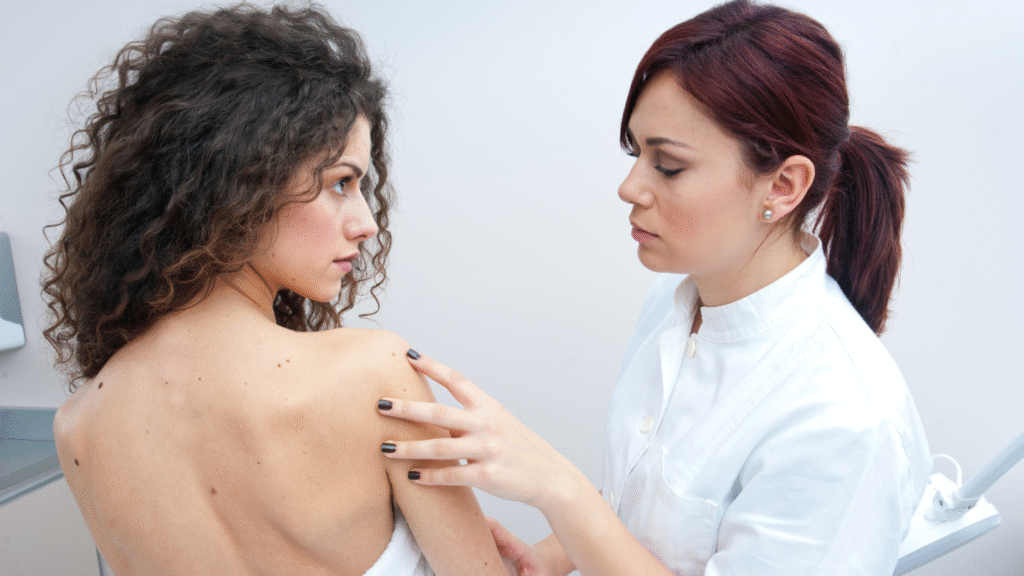Moles are common skin features that most people have from a young age. While the majority are harmless, some can develop into serious health concerns, including melanoma—the most dangerous form of skin cancer. Because it’s difficult to determine whether a mole is normal or potentially harmful just by looking, professional mole evaluations play a vital role in protecting your overall skin health.
Self-checks are important, but they’re not a substitute for a trained medical eye. Dermatologists have the tools, experience, and diagnostic precision needed to evaluate moles thoroughly and detect warning signs early. Below are the top reasons why scheduling regular mole evaluations with a skin specialist is one of the smartest decisions you can make for your health.
1. Early Detection of Skin Cancer Saves Lives
Melanoma can be deadly if not caught early, but it’s also one of the most treatable cancers when diagnosed in its early stages. Professional mole evaluations help identify irregularities before they become life-threatening. Dermatologists are trained to recognize even the most subtle changes in a mole’s size, shape, color, or texture—indicators that could signal precancerous or cancerous activity.
Using specialized tools like dermatoscopes and digital imaging, dermatologists can examine moles with far greater accuracy than the naked eye. These evaluations are often the first line of defense against skin cancer and can lead to life-saving early intervention.
2. It’s Difficult to Self-Diagnose Risky Moles
Many people are unaware of what a potentially dangerous mole actually looks like. While guidelines like the ABCDE rule (Asymmetry, Border irregularity, Color variation, Diameter over 6mm, and Evolving shape or size) are helpful, they aren’t foolproof. Some melanomas may not meet all these criteria, and some benign moles might appear suspicious to the untrained eye.
A dermatologist has years of education and clinical experience to distinguish between normal variations and potential red flags. They can also compare current mole patterns with past records or body mapping images, spotting changes over time that would otherwise go unnoticed.
3. Peace of Mind for High-Risk Individuals
If you have a family history of melanoma, a personal history of sunburns, fair skin, or a large number of moles, you may be at greater risk for developing skin cancer. Professional mole evaluations provide reassurance that your skin is being closely monitored by an expert.
For high-risk individuals, dermatologists may recommend full-body skin checks on a regular basis—sometimes annually, semi-annually, or more frequently, depending on your risk level. Knowing that an expert is keeping a close watch helps reduce anxiety and ensures any changes are addressed quickly.
4. Not All Problematic Moles Are Cancerous—But They Still Need Attention
Suspicious moles aren’t always cancerous, but that doesn’t mean they can be ignored. Some may be classified as atypical or dysplastic nevi—moles that aren’t cancerous but could become problematic over time. These moles may require monitoring, removal, or biopsy to ensure they don’t pose a future risk.
In some cases, moles may also cause irritation or discomfort due to their size, location, or rubbing against clothing. A dermatologist can assess whether removal is warranted for comfort, cosmetic reasons, or health concerns. Professional evaluations provide clear guidance on what should be treated and what can safely be left alone.
5. Professional Removal Minimizes Scarring and Complications
If a mole needs to be removed, a professional dermatologist can ensure the procedure is done safely and with minimal impact to the surrounding skin. DIY mole removal or treatments done by non-medical providers can result in infection, scarring, or incomplete removal, which may delay critical diagnoses.
When done in a clinical setting, mole removals are clean, efficient, and tailored to the nature of the mole. If the mole is sent to a lab for further testing, results can help determine next steps in treatment or monitoring.
6. Part of a Comprehensive Skin Health Plan
Mole evaluations aren’t a one-time fix—they’re a key part of a long-term approach to healthy skin. Regular visits to a dermatologist for mole checks are just one element of a proactive skincare strategy, especially for those concerned about aging, sun exposure, or other dermatological conditions.
These evaluations often go hand-in-hand with other dermatology services, including full-body skin exams, lesion assessments, sun damage treatment, and education on proper sun protection. When you work with a qualified professional, you gain more than just a diagnosis—you gain a partner in your skin health journey.
Your skin is the largest organ of your body, and keeping it healthy requires more than just a good skincare routine. Professional mole evaluations are an essential tool for early detection, prevention, and long-term monitoring of skin conditions that could otherwise go unnoticed. Whether you’re at high risk for skin cancer or simply want to stay ahead of any potential issues, seeing a dermatologist regularly for mole checks is one of the best decisions you can make.
Don’t leave your skin health to guesswork. Schedule a professional evaluation and take the first step toward lifelong protection and peace of mind.

